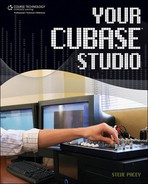Setting Up and Recording a MIDI Drum Kit with Cubase
As you can probably guess, there are many benefits to using a MIDI drum kit in a home Cubase studio. Not only can you save loads of time, but you’re also probably going to get the best-sounding recording because getting good drum sounds hinges on so many variables.
In this short walkthrough, I explain the easiest way to interface a MIDI drum kit with Cubase. Since there are several different types of kits and brains on the market, I use general references that every drum brain should have.
1. | First, connect the MIDI drum kit to the drum brain as instructed by the kit’s manufacturer. |
2. | Run a MIDI cable from the drum brain’s MIDI Out to the MIDI In of your computer’s sound card/MIDI interface. |
3. | Run a MIDI cable from the sound card of your computer’s MIDI Out to the MIDI In of your drum brain. |
4. | Run some audio cables from the stereo output of the drum brain to two analog inputs on your sound card. If the drum brain has a digital (SPDIF) output, run that output to your sound card’s SPDIF input (for better sound quality). |
5. | Follow my walkthrough in the section “Making Connections to an External Synth” earlier in this chapter to make sure your audio is connected and monitored through an audio track in Cubase. Make sure that your global MIDI transmit channel is set to the same MIDI channel on the MIDI track you’re recording to in Cubase. Also make sure that your global MIDI receive channel is set to the same channel you’re working with. Because drum sounds are usually set up on different note numbers (as opposed to using separate patches), you should only need to use one MIDI channel to record an entire drum part. Refer to your MIDI drum kit’s manual for help on proper settings. |
6. | Set your drum brain to Local Off (refer to your drum kit’s manual). That way you will only be able to hear the sound from the drum kit as the MIDI has passed though Cubase. With Local On, you would receive a doubled sound: the sound of the MIDI as it is generated with the brain and the sound as the MIDI is regenerated in the brain when it reenters the brain from Cubase. |
7. | If you are experiencing a slight delay between a drum hit and the drum sound, try adjusting the latency of your sound card. This is a common problem when working with MIDI because MIDI definitely doesn’t travel as fast as sound normally travels from a drum to a drummer’s ear. No matter what your settings are, this MIDI delay may take some time to get used to before recording. Because of the way the MIDI is set in this example, it may create a slightly longer delay. If this is unbearable, try disconnecting the MIDI In on the drum brain and recording with the drum brain’s Local On setting activated while recording. Then, when you’re finished recording, reconnect the MIDI cable so you can listen to what you’ve recorded. Note When recording MIDI or audio, it’s important to always make sure the red Record button is enabled on the MIDI track you will be recording on. There is also a button that looks like a speaker that you can use to monitor your MIDI signal without recording. |
8. | Continue recording as in the walkthrough in the section “Recording MIDI Using a VST Instrument” earlier in this chapter. If your MIDI is connected properly from the MIDI Out of your computer to the MIDI In of your drum brain, you should be able to replay your recording and change the drum kit within the drum brain as you listen back. See Figure 4.17 for a basic configuration. Figure 4.17. A basic configuration for a MIDI drum kit using Cubase.
|
Many MIDI drums kits’ brains have multiple outputs for each individual drum sound. While these are great for monitoring and mixing a live performance, they aren’t really necessary with a Cubase studio. If you have recorded the MIDI info from the MIDI drum kit properly, when it comes time to record the audio of each drum separately, you should be able to mute or solo drums during playback, which will allow you to record a solo audio track in one pass of the entire song. After this track has been recorded, you can then solo another drum and repeat this process until every drum in the drum part has been recorded. Keep in mind that this should all happen after the MIDI drum track has been recorded. Using this simple method will not only allow you to record drums individually for each pass but will also allow you to record groups of drums or other drum sounds using the same MIDI track. For more on muting drum sounds within your MIDI drum brain, refer to your drum kit’s manual. You can also mute individual notes and sounds using Cubase’s MIDI Drum Editor, as I will show you in the next section. Check out Chapter 9 for more information on bouncing down MIDI drum tracks to an audio track.

